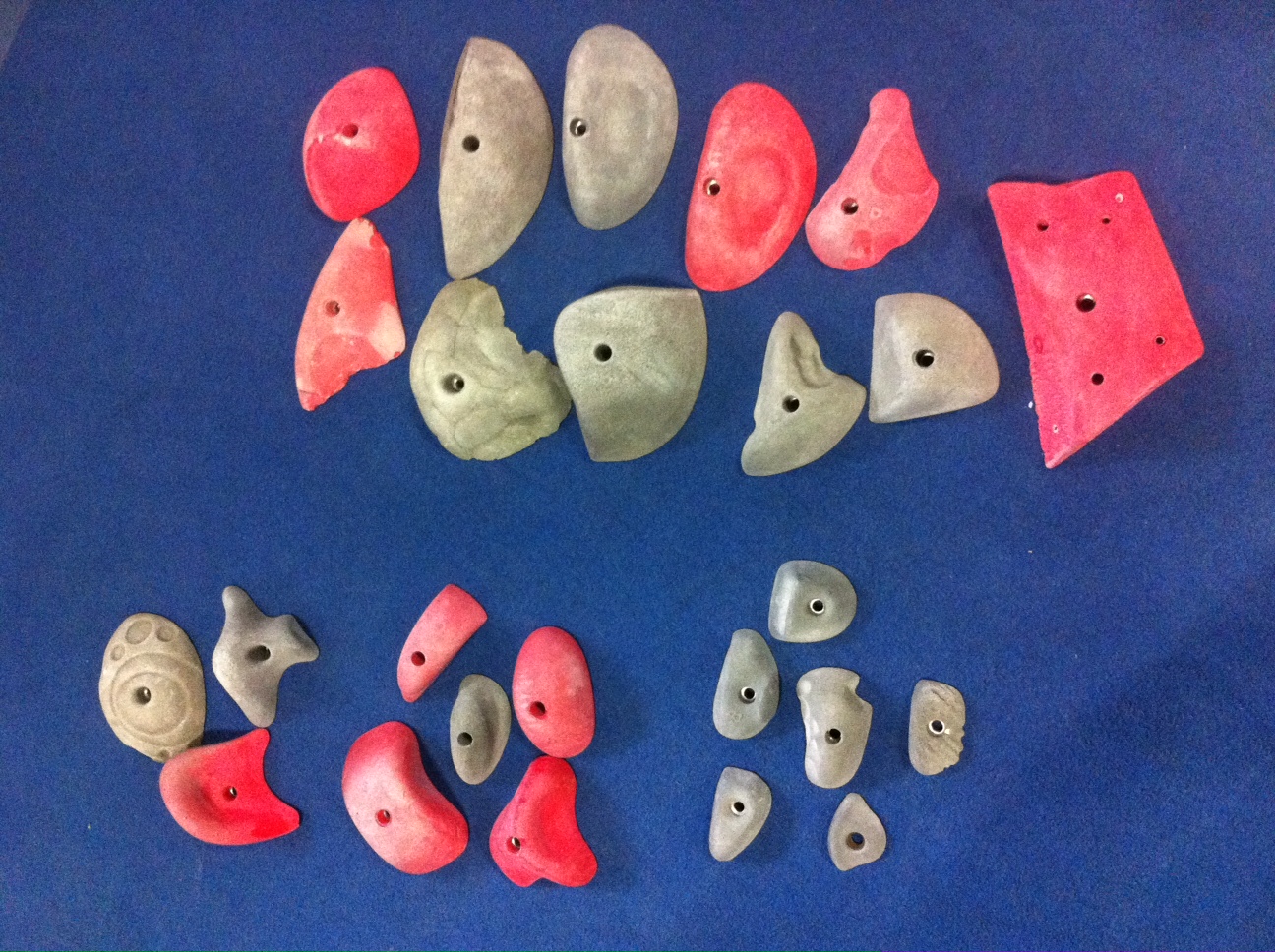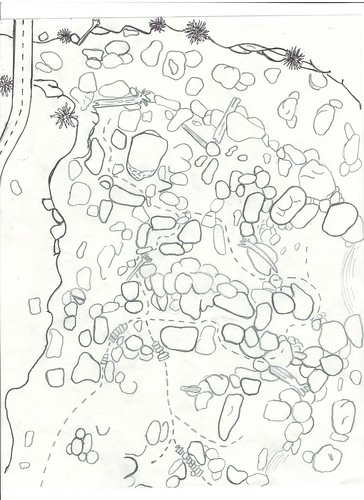 Being a wrestler, I got used to big crowds, being under a lot of pressure to perform well, and being by myself, in my own head, figuring things out on the mat. It was awesome! My teammates couldn't score
Being a wrestler, I got used to big crowds, being under a lot of pressure to perform well, and being by myself, in my own head, figuring things out on the mat. It was awesome! My teammates couldn't score
points for me; my coaches couldn't pin my opponent; my parents couldn't win my match. It was all up to me and the work I had done prior to the match.
 The same thing applies to climbing. Except, rather than an opponent, I get to wrestle an arbitrary set of objects placed in a vertical space. And, yet, the two sports almost perfectly mimic each other, especially when it comes to mental preparation, body awareness, muscle memory, and psych level. All sports, for that matter, have similar qualities in that regard, but there is something different about being a lone athlete, relying on ones own mental and physical abilities to reach goals, rather than also relying on a teammate(s) to get the job done.
The same thing applies to climbing. Except, rather than an opponent, I get to wrestle an arbitrary set of objects placed in a vertical space. And, yet, the two sports almost perfectly mimic each other, especially when it comes to mental preparation, body awareness, muscle memory, and psych level. All sports, for that matter, have similar qualities in that regard, but there is something different about being a lone athlete, relying on ones own mental and physical abilities to reach goals, rather than also relying on a teammate(s) to get the job done.I had the chance to revisit that "lone athlete" feeling at the ABS 15 National Championships in Colorado Springs last weekend. It was an enjoyable and familiar feeling, reminding me why I have spent the better part of my life training and competing in various sports. Not only was in enjoyable, but it also kicked my ass!
did some pull-ups, push-ups... you know, some "training."
I did, however, spend a lot of time visualizing, remembering moments where I had performed well in competitions, making a game plan for competition
I did, however, spend a lot of time visualizing, remembering moments where I had performed well in competitions, making a game plan for competition
day, and trying to give myself the most control and competence while outthere for my first on-sight comp ever!
"Climbers, you may begin climbing now!" As soon as I heard those words, all my preparation and planning vanished; it all went out the window! All the patience and control I thought I would have out there dissolved into a puddle of panic and what felt like some relatively aimless attempts at some really hard boulder problems - some of which I'm sure I could do now. I had little control over my conscience, like I thought I would. Four minutes is not a lot of time to climb a boulder problem. It feels like even less time with the added pressure to climb well.
 Despite my struggles to actually place well, I think I definitely met my goals of having fun and learning some things! I wanted to experience what the kids from the climbing team I coach (the Bend Endurance Academy) go through at every on-sight comp they climb in. I also wanted feel, first hand, what a national level on-sight boulder problem felt like. And finally, I wanted to watch the best climbers in the nation compete on some of coolest boulder problems I have ever seen!
Despite my struggles to actually place well, I think I definitely met my goals of having fun and learning some things! I wanted to experience what the kids from the climbing team I coach (the Bend Endurance Academy) go through at every on-sight comp they climb in. I also wanted feel, first hand, what a national level on-sight boulder problem felt like. And finally, I wanted to watch the best climbers in the nation compete on some of coolest boulder problems I have ever seen!
Climbing these problems gave me a whole new appreciation for power-endurance! Obviously, having the strength to pull on the hard moves is important, however, I think that having the endurance to continue pulling on more moderate moves is more important. More points are to be had by doing several more moves throughout a comp than doing one or two really hard moves. Take that with a grain of salt, obviously. There are benefits to both.
 From my experience, I also learned how important doing on-sight practice is. Climbing under the USAC format of four minutes on - four minutes off is completely different than projecting a hard problem at the gym. There is very little time to think. I spent most of my four minutes brushing holds, sequencing, and then telling myself, "alright, time to go for it and trust my instincts!" And that's what I did. I just started climbing and I trusted the work I have put into my climbing over the years. Furthermore, not only will on-sight practice help me perform better in competitions, but I think it is absolutely vital for improving and becoming a more intuitive climber in general. Any chance I get to on-sight something, I will give it my all and try to learn as much as I can from it!
From my experience, I also learned how important doing on-sight practice is. Climbing under the USAC format of four minutes on - four minutes off is completely different than projecting a hard problem at the gym. There is very little time to think. I spent most of my four minutes brushing holds, sequencing, and then telling myself, "alright, time to go for it and trust my instincts!" And that's what I did. I just started climbing and I trusted the work I have put into my climbing over the years. Furthermore, not only will on-sight practice help me perform better in competitions, but I think it is absolutely vital for improving and becoming a more intuitive climber in general. Any chance I get to on-sight something, I will give it my all and try to learn as much as I can from it!
From a routesetting perspective, the trip to Colorado Springs was really informative. Climbing these problems gave me a better idea of how hard to make on-sight problems/routes and what types of moves and sequences can be used. Honestly, I don't believe the problems were extremely difficult. Several of them were definitely in my range, especially if I had more time to work on them. However, the format of the competition is partially what makes these problems hard to do. The other part of what made this competition tough was that the problems were really difficult! Problem #3 was balls hard and #4 was up there as well. So, going back to what to work on for competitions, I guess I need to increase my strength as well as my power endurance!
One of the most exciting things about this trip, besides competing, was being able to watch the finals live! Being a part of the crowd, cheering on my favorite climbers, and watching the action, first hand, was very memorable and fun. I'm not going to say I was anti-cheering for anybody in particular, but I definitely wanted to see a new national champion on both the men's and women's sides. Although there wasn't a new national champion (again!) Wurm sure put on a great show and proved that Puccio can be beat! Also, watching the younger climbers give the veteran climbers a run for their money was very inspiring. It kind of makes me feel fairly hopeless for myself, as far as doing well on the national level goes. Then again, there are guys like Vasya, who is 30 years old, that are giving Daniel a run for his money. It's anyones' game... so they say.
(Matty Hong and Megan Mascarenas gettin' it done in the Semis!)
(D. Woods, Traversi, Wurm, and Mascarenes. Ducks in a row! and the back of Puccio's head...)
As for right now, I have less than a year until I head to Madison, Wisconsin for the ABS 16 National Championships! Who wants to do some training!?
See ya'll out there...
























